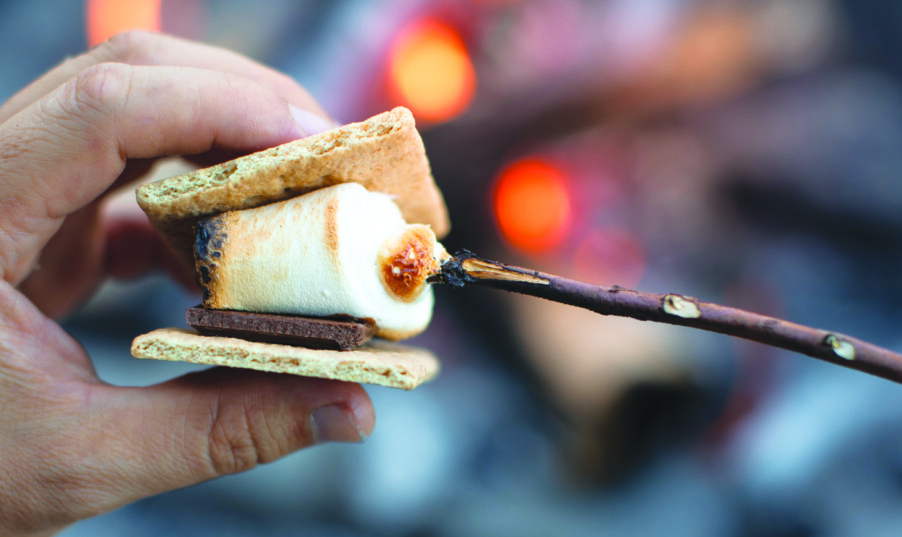Exciting new adventures in graham cracker, marshmallow and chocolate
S’mores seem like a good bet.
They only have three ingredients. You have access to sticks. And even though the leaves have turned and the nights are cold, s’mores, with their accompanying campfire, give you a good reason to keep the deck furniture out a few more weeks. What could possibly go wrong?
Aw, jeez, I just jinxed it, didn’t I? Now even roasting marshmallows seems like too much to wrap your head around. OK, let’s break this down to its essential components: graham crackers, marshmallows, chocolate and fire. We’ll ease into it.
The Graham Crackers
Graham crackers are a good place to start. They were designed to be non-threatening. They were invented by the followers of Sylvester Graham, a 19th-century preacher and nutritionist, who was convinced that white flour, sugar and meat of any kind led to poor health and impure thoughts. If you think that you wouldn’t have been likely to get along with him, an angry mob of bakers and butchers in 1837 Boston would agree with you. They laid siege to his hotel while he was on a speaking tour, and were only dispersed when Graham and his followers dropped bags of cement on them from the hotel roof.
Commercial graham crackers, the ones we remember from kindergarten, are delicious, inexpensive and easily available, so who would make them from scratch?
You would. As long as you don’t expect perfection.
Lindsey Bangs, the baker of I Whisked It, a homestead bakery in Raymond, says that the secret is rolling the dough to a consistent thickness.
“If you don’t get the dough completely even, the edges will be a little crispy while the center isn’t done yet.”
This isn’t a huge problem for home bakers but would be a logistical headache for a commercial baker, which is why you don’t see house-baked graham crackers in bakeries very often, she says. But making them yourself also allows you to take some liberties in how you flavor them — adding cardamom, or even a little black pepper.
“Adding more cinnamon would really bump the flavor profile up,” Bangs says.
She likes her marshmallows gently toasted and golden brown.
Homemade Graham Crackers
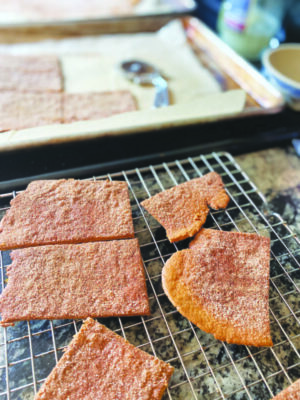
Lindsey isn’t kidding about how fiddly graham crackers can be. They are straightforward enough to make at home, but making them professionally would be like juggling ice cubes. If you follow each step, though, you will be very pleased with the result.
A note on substitutions:
When making comfort foods, it is very tempting to jazz up a recipe. By their nature, comfort foods are basic; they are there to comfort, not to inspire or excite or intrigue the eater. This is why there are so many recipes and articles about mashed potatoes. Everyone wants to mess with them, but when someone is burned out from work or nursing a broken heart or feeling homesick, they do not want blue cheese in their mashed potatoes.
Most of the ingredients in this recipe lend themselves to intriguing substitutions. I would recommend restraint; feel free to change one ingredient. More than that will muddle the flavor of your graham crackers. Even one substitution will probably get you a pointed comment from a graham cracker purist.
- 1 cup (113 g) Whole wheat flour – You could use stone-ground whole wheat flour for this, but that would be your one substitution.
- 1 cup (120 g) all-purpose flour – Don’t experiment with this; you don’t want to toughen or soften the texture of your graham crackers by using bread or pastry flour.
- ¼ cup (50 g) white sugar – or brown sugar, or maple syrup, but that would be your one substitution.
- ½ teaspoon salt – I like kosher salt, but again, well, you know.
- 1 teaspoon ground cinnamon – I like smoked cinnamon.
- 1 teaspoon baking powder – There isn’t really a substitution here, but did you know that you should replace your baking powder every six months? Weird.
- 1 large egg
- ¼ cup (50 g) vegetable oil – or hazelnut oil
- ¼ cup (85 g) honey – or hot honey
- 2-3 Tablespoons (28-43 g) milk
- more milk to make cinnamon sugar cling to the top of your crackers
- cinnamon sugar for topping (optional)
In a large bowl, whisk together the dry ingredients – the flours, salt, cinnamon, and baking powder.
In a separate bowl, whisk together the wet ingredients – the sugar, egg, oil, honey, and milk. I don’t know why sugar is considered a wet ingredient, but it is, and it works better when you treat it that way. Chemistry is weird.
Add the wet ingredients to the dry ones, then stir to combine. You might have to knead the dough a little to bring it together.
Wrap the dough, and chill it for at least an hour.
Preheat your oven to 300º (150º C).
Divide the graham cracker dough in half.
Roll each batch of dough to 1/16 inch thick. It is important that the dough is consistently thick. Is there an easy way to do that? And how thick is 1/16 inch, anyway?
Here’s how you’re going to preserve your sanity. Lay down a sheet of parchment paper, and weigh it down with half your dough. Flatten it out a little with the heels of your hands. It turns out that the wire in most clothes hangers is made of 12-gauge steel, 1/16 of an inch thick. Place a clothes hanger on either side of your dough, then cover everything with another layer of parchment paper.
Using the wire as a guide, roll the dough out as thick as the hangers. As you get your dough thinner and thinner, each end of your rolling pin will rest on one of the hangers.
Peel the top layer of parchment paper from each batch, then slide the bottom layer onto a baking sheet, then repeat the whole process with the other half of the dough.
If you are going the cinnamon-sugar route, brush each sheet of dough with milk, and sprinkle it with the cinnamon-sugar.
Bake the sheets of dough for five minutes, rotate them, then bake them for another five minutes.
Remove each sheet from the oven and cut to shape with a bench scraper or a pizza cutter.
Return the dough to the oven, and bake for another 20 minutes or so.
This is the part that seems really fiddly, but it’s important if you want your graham crackers to be crisp and not bendy:
Turn off the heat, and open the oven door all the way. Let it cool for five minutes, then close the door again, and let the crackers cool in the oven for another 20 minutes.
Transfer the graham crackers to a cooling rack. At this point they are exquisitely crispy. They should stay crispy, though not crunchy, for a couple of days, depending on how humid the air is. If you have any of those “Do Not Eat” dehydration packets saved, put those with the crackers in an air-tight container, and maybe store them in your refrigerator, which is the driest place in your kitchen.
So, the natural question: Is making your own graham crackers worth the trouble?
First of all, the number of steps involved is misleading. Tying your shoes or organizing your sock drawer would probably involve 72 separate steps if you broke it down. None of these graham cracker steps is very complicated. I know that there are days when you feel like opening an oven door is at the outer limit of your ability, but you can totally do this.
Secondly, these are delicious. Most of us have never had a thoroughly crisp graham cracker, warm from the oven. It is warm, but crunchy, gently sweet, but with tiny bursts of salt, and — depending on how well you were able to restrain yourself — with a little something extra.
This recipe is based on one from King Arthur Flour, my first stop when looking for any baking recipe. Their recipes are pretty much bullet-proof, but here’s something that even they won’t tell you: Flip a warm-from-the-oven graham cracker upside-down, and smear the bottom with butter. It is the most decadent legal experience you are ever likely to have.
The Marshmallows
When it comes to marshmallows, Sherrie Paltrineri knows what she’s talking about. She runs Sweet & Sassy, a small candy company specializing in pre-made s’mores. It’s fair to say that she’s not a s’more purist.
“Right now we’re making s’mores with up to 12 flavor profiles per week,” she says. “As we get into the fall season, we have pumpkin spice, of course, but we play around with Dark Chocolate with Raspberries, Orange Cranberry, and even Mochaccino.” According to Paltrineri, the surprise sleeper hit of this past summer was made with root beer flavored marshmallows.
She likes her marshmallows completely torched. “I love them burned; I want them to go up in flames,” she says.
Cooking with Marshmallows
There are a lot of people who will assure you that making your own marshmallows from scratch is relatively easy and very rewarding. I am not saying that those people are wrong, but my most recent attempt at home marshmallowing went badly. The term “fiasco” is too kind to describe it accurately.
I am not saying not to try it. There are many very nice instructors who can walk you step-by-step through the process — Martha Stewart springs to mind — but they could speak to this much more authoritatively than I can.
But is there a marshmallow-forward recipe that we can tackle that will help guide you toward s’morehood?
As it turns out, there is:
Toasted Marshmallow Ice Cream
- 1 10-ounce bag of mini marshmallows
- 4 egg yolks
- pinch of kosher salt
- ½ cup (99 g) white sugar
- 3 cups (735 ml) half and half
- 2 teaspoons vanilla
Toast the marshmallows under the broiler in your oven, or with a blowtorch, either one of the tiny kitchen ones or a regular no-pretense plumber’s blowtorch from a home center. (I like the one with a pistol grip; it has a great sound. Hissssssss, click, WHUMP!) The torch will allow you to get a little more variety in how dark you toast the marshmallows, but in any case, if you prefer them toasted a gentle golden brown, cook them a little darker than you might otherwise do. The ice cream base will dilute the flavor slightly, and a darker marshmallow will bring more marshmallow flavor.
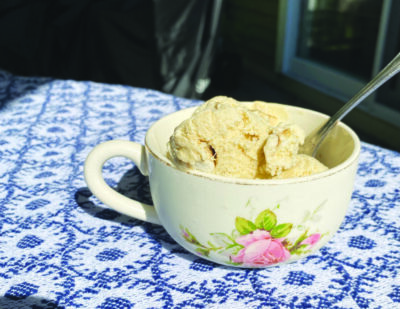
Combine egg yolks, salt, sugar and cream in a small saucepan.
Heat, whisking, until the mixture reaches 175ºF/80ºC.
Strain the hot mixture over 2/3 of the toasted marshmallows. Add the vanilla, and whisk the mixture until it is as smooth as it’s going to get. Do not let this step worry you; clumps of semi-melted marshmallows in this ice cream is not a bad thing.
Chill the mixture for at least three hours or overnight, then churn according to your ice cream maker’s manufacturer’s instructions.
When spooning the soft-serve-textured ice cream into containers, layer with the remaining toasted marshmallows, before hardening it off in the freezer.
Even die-hard marshmallow fans will admit that they can be a little (unrelentingly) sweet. This ice cream carries the toasted marshmallow flavor gently, in a just-sweet-enough base. The flavor is delicate enough that you will probably not want to eat this with any topping that might overpower it.
This is a definite winner.
The Chocolate
Let’s face it: It’s the chocolate that makes or breaks a s’more. The graham cracker provides texture, and the marshmallow provides sweet stickiness, but it is the chocolate that sets the tone for the whole enterprise.
Should you go with a classic milk chocolate, or something darker? Should you let it melt completely, or let your marshmallow cool a little so you still have some resistance to your teeth? Should you use a classic American candy bar or something a little shmancy?
According to Jeffrey Bart, the owner of the Granite State Candy Shoppe in Concord and Manchester, most people don’t put enough thought into this.
“Many times, someone will just break up a chocolate bar and hope for the best,” he says. His suggestion is to either use two types of chocolate or to finely chop some, but not all, of the chocolate, and use both in a s’more. The little pieces, having more surface area, will melt easily. “That hits the perfect ratio of totally melted and fused with the graham cracker,” he says, “and something to still bite into.”
He prefers his marshmallow gently toasted.
“I’m of the Low and Slow camp,” Bart says.
Rob Delaney and Maggie Pritty of Worldwide Chocolate in Brentwood agree that texture is important but stress the importance of picking the right flavor profile.
“Personally I’d go with a dark milk chocolate,” Delaney says, “which is not a thing that a lot of people are even aware exists.” He says that some dark milk chocolate can have as high a cocoa percentage as 55 to 70 percent, as opposed to the usual 35 percent or so for a typical grocery store chocolate bar. “That would have that milky, caramelly character, without being so sweet.”
Pritty stresses the importance of reading the label on a bar of chocolate. “Make sure to look at the ingredients,” she says. “You want to see that it’s made with cocoa butter and sugar, not hydrogenated palm oil or anything like that.”
She likes her marshmallows dark brown but not quite burnt.
So is there something chocolate-forward and s’moresy that will build your confidence back up?
Yes. Yes, there is.
Dark Chocolate Cheesecake with Graham Cracker Crust and Toasted Marshmallow
Crust
- 403 g graham cracker crumbs – this is almost exactly equal to one box of graham crackers
- 4 Tablespoons (56 g) butter, melted – this is half a stick
Cheesecake Filling
- 24 ounces (678 g) cream cheese, room temperature – this is three 8-ounce packages
- 1 cup (207 g) sugar
- 6 Tablespoons (43 g) dark cocoa powder
- 1 cup (230 g) sour cream, room temperature
- 1 teaspoon vanilla extract
- 8 ounces (227 g) dark chocolate, melted and slightly cooled
- 4 eggs, room temperature
Marshmallow Topping
- 1 7.5-ounce jar of marshmallow cream
Preheat oven to 325°F (163°C). Line a 9-inch (23 cm) springform pan with parchment paper in the bottom and grease the sides.
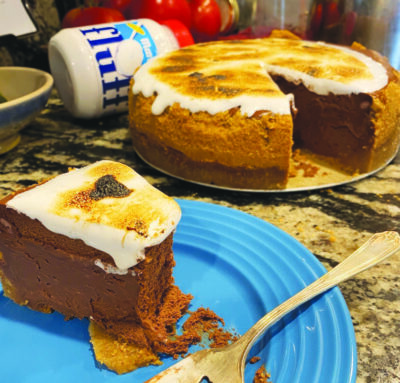
Combine the graham cracker crumbs and melted butter in a small bowl. Press the mixture into the bottom and up the sides of the springform pan. It will seem like too much crust, until it doesn’t.
Bake the crust for 10 minutes, then set aside to cool
Put your chocolate in a microwave-safe bowl, and heat, 15 seconds at a time, to melt it. Stop when it still has a few lumps. If you stir it at that point, everything will melt without getting too hot.
Cover the outside of the pan with aluminum foil. This is to more-or-less waterproof it, when it goes into a water bath. (Yes, there will be a water bath. Don’t panic. As the Winter Warlock® once put it, put one foot in front of the other.)
Reduce the oven temperature to 300°F (148°C).
In a large bowl, beat the cream cheese, sugar and cocoa until completely combined. If you use an electric mixer, use your lowest speed for this. Because Reasons.
Add the sour cream and vanilla, then mix to incorporate them.
Add the melted chocolate in three parts, stirring to combine each time.
Add the eggs, one at a time, mixing after each addition.
When everything is completely combined, pour the cheesecake batter into your foiled-up springform pan.
This is where the water bath comes in. In old recipes, it will be called a bain marie. Put your foiled-up pan inside a larger pan, maybe a turkey-roasting pan. (If, like me, you don’t have a pan that big, use your largest non-melty mixing bowl.) Gently fill the larger pan or bowl with hot water that reaches about halfway up the side of your springform pan.
Bake for about 70 minutes. Don’t panic and open the door too much. The whole reason for the water bath is to provide gentle steady heat to your cheesecake. It will have your back for one or two viewings, but try to exercise some restraint. Set a timer, and go clean out your refrigerator. You will not believe what there is in there.
After your timer goes off, check on your cheesecake. It shouldn’t be ready yet, but it will have a nice skin on top of it and be a little wiggly in the middle. Turn the oven off, but leave the cheesecake inside with the door closed, to finish cooking gently. Leave it for another hour.
When the oven is much cooler and your cheesecake has an internal temperature of 150º-175º F (65º-80º C), remove it from the oven, and let it cool on your countertop, then refrigerate for three to five hours or overnight.
When your cheesecake is completely cooled and firm, take it out of the refrigerator and de-pan it. You will rightfully feel proud.
But you’re not done yet.
Coat the top of the cheesecake with marshmallow cream. Use your own judgment as to how much you want to use.
Toast the marshmallow layer. Yes, you could do this under your broiler, but I prefer to use a blowtorch, either one of the mini ones designed for kitchen use or a plumber’s torch from the hardware store.
Serve immediately. If you aren’t serving a dozen people — though if you aren’t, why aren’t you? — wait until service before topping each slice with Fluff individually, then torch it in front of your guests, which is probably more dramatic anyway.
Much like a s’more, this is a very rich, deeply chocolatey treat. Even if you are a “more is more”-type person, you might want to start with a small slice of this. Its intense chocolateness is balanced by the sour tang of the cream cheese and sour cream, but it is still very, very rich. If you wanted to freeze this (and why wouldn’t you?) small slices might be even better.
The Fire
The only element left to discuss is the fire.
Yes, you could toast your marshmallow over the last coals in a charcoal grill, or even a gas one. In an emergency, you could toast it over one of the front burners in your kitchen, especially if you have a gas stove.
But half the experience of making s’mores is navigating actual flames — flirting with disaster, if you are a gently-toasted-golden-brown person, or plunging your marshmallow into the heart of the flame if you belong to the go-for-broke, fully-torched school of marshmallow toasting.
The key to a good marshmallow fire, according to 15-year-old Eagle Scout candidate Hailey Hansen, is starting small: “When I make a fire, I like to make a log-cabin fire, with sticks stacked like walls to a house, but you have to start from the bottom first, with tinder, then kindling, and larger and larger sticks, before you get to that stage.”
She says that coals are better for any campfire cooking, as they provide a steady, dependable heat, which lets a marshmallow roaster confidently choose how done they want to roast their marshmallow, but it’s not a binary situation:
“Your fire doesn’t have to be all coals. You can have half with flames, but let the other half burn down to safer” — by this, she clearly means “old person” — “coals,” she says.
Hailey likes her marshmallows golden brown and crispy but thoroughly melted inside.
At this point you must be feeling pretty confident s’mores-wise. If you can handle that cheesecake, you can host a s’mores party with one hand tied behind your back. But maybe you would like one more easy recipe to keep you bucked up until then. Is there an easy recipe that you can make to keep everyone on a short leash until it’s actually S’mores Time?
As a matter of fact, yes, there is.
S’mores Candy
- Some marshmallows — the big ones, the mini ones, whatever you have around
- Some graham crackers — you know you’re going to have to buy a new box, anyway, so you might as well use up what you have handy at the moment
- Some peanut butter — all natural, or the kind that children actually like, it’s up to you.
- Some chocolate — any chocolate: white, milk, dark, whatever you have stashed away in that cupboard that the kids can’t reach.
Crush the graham crackers into crumbs. A food processor is good for this.
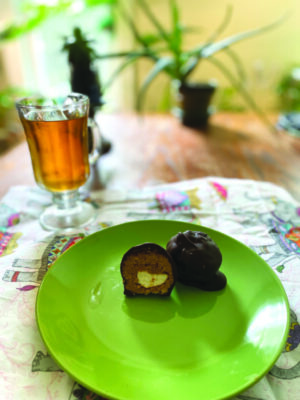
Mix the crumbs with peanut butter — however much it takes to make a nice, stiff dough. You will almost certainly start doing this with a spoon, but almost as certainly end up mushing it altogether with your hands. You decide when it is the right consistency; this is one final exercise to get in touch with your s’mores instincts.
Melt the chocolate in your microwave. (See cheesecake recipe, above)
If you are using large marshmallows, cut them into quarters or eighths. If you are using mini-marshmallows, just let them be themselves.
Coat the marshmallows with the peanut butter dough you just made. You will probably need to play with it in your hands a little, before it reaches the consistency you want, and more-or-less covers the marshmallow. This doesn’t have to be perfect (because of the next step).
Drop the marshmallow/graham cracker/peanut butter ball into the melted chocolate, and then roll it around with a fork, until it is completely coated.
Remove the candy from the melted chocolate with your fork, then gently place it on a plate covered with a piece of waxed or parchment paper.
Repeat this until you run out of an ingredient. Don’t worry if you have some left over; any extra will mysteriously disappear.
Refrigerate the candies for at least 20 minutes. They are very good with tea.
Putting It All Together
At this point you might expect step-by-step instructions on how to make s’mores, but that would be silly. You have known how to make a s’more since you were 5 years old. It was probably the first food you learned to cook. It is less complicated to put together than toast.
Step 1: Toast a marshmallow
Step 2: Put a piece of chocolate on half a graham cracker, then sandwich the marshmallow between the two cracker halves.
(I do have a preference for Mexican chocolate — the gritty stone-ground kind — but when I mentioned this to our three chocolate experts, they stared at me in shock, then started to speak to me in very small words, so use whatever kind suits you personally.)
However, I do have one final recipe:
S’mores Martini
Graham Cracker Vodka
- 1 sleeve (135 g) graham crackers
- 3 cups 80-proof inexpensive vodka

Combine graham crackers and vodka in a blender. Blend at whatever speed pleases you for about one minute. Feel free to chuckle evilly as the graham crackers meet their fate.
Pour into a wide-mouthed, air-tight jar.
Store in a warm, dark place for a week, shaking twice daily.
This is really important: On Day 7, DO NOT SHAKE THE JAR.
Gently pour the clear liquid through a fine-meshed strainer, let it settle, then pour it through a coffee filter, into a labeled bottle.
Chocolate Vodka
This is very similar to the previous recipe.
- ¼ cup/1 ounce/30 g cocoa nibs. Cocoa nibs are the raw ingredient for chocolate-making. You can find them in an upmarket grocery store or online. I like ones from Guittard. They come with this warning: “May contain shell, kernel, plant material or other material from the growing process. Inspect or re-clean before using. This is not a Ready-to-eat food.” In other words, just exactly what we’re looking for in this application.
- 2 cups middle-shelf vodka
Combine the cocoa nibs and vodka in a large wide-mouthed jar, seal, shake vigorously, then place in the basement or under the sink, with the graham cracker vodka.
Shake twice per day for four days.
Strain, filter, and bottle, as above.
S’mores Martini
- 1 ounces crème de cacao
- 2 ounces chocolate vodka
- 2 ounces graham cracker vodka
- a toasted marshmallow, for garnish
In a mixing glass, rinse several ice cubes with crème de cacao, then pour it off.
Pour equal amounts of chocolate and graham cracker vodka over the liqueur-rinsed ice.
Stir gently but thoroughly.
Pour off, into a chilled martini glass.
Garnish with toasted marshmallow, much like you would a conventional martini, with an olive.
The surprising thing about this martini is how well the flavor of graham crackers comes through. Make no mistake; this is a strong, fully adult cocktail. It is not nearly as sweet as you might be tempted to think. This is a s’more to drink in small sips.
Featured Photo: Courtesy photo.

